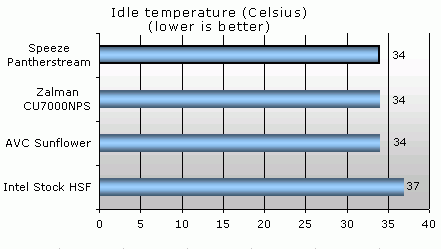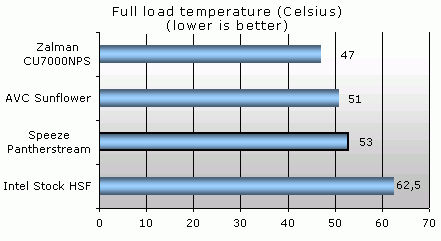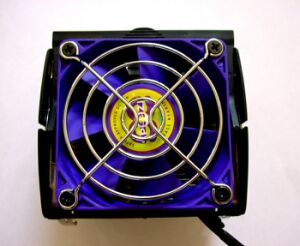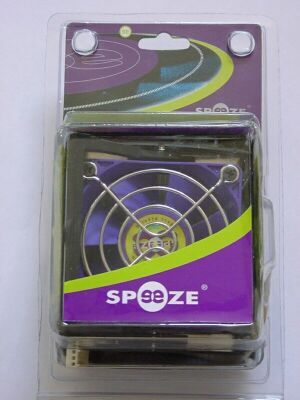Speeze is for many a rather unknown Chinese manufacturer of cooling and modding products. The product line consists mainly of CPU coolers designed with the classic Fan+Heatsink design, but there is also a lot of space for new ideas which we saw at this year’s CeBIT. There Speeze showed a cooler equipped with a peltier for cooling today’s very hot processors. Many manufacturers have tried this, and most of them have been more or less unsuccessful, you need a powerful fan to move the warm air a peltier causes.
Speeze is for many a rather unknown Chinese manufacturer of cooling and modding products. The product line consists mainly of CPU coolers designed with the classic Fan+Heatsink design, but there is also a lot of space for new ideas which we saw at this year’s CeBIT. There Speeze showed a cooler equipped with a peltier for cooling today’s very hot processors. Many manufacturers have tried this, and most of them have been more or less unsuccessful, you need a powerful fan to move the warm air a peltier causes. This is in other words a very noisy fan. Speeze’s cooler in other hand were going to be temperature controlled to avoid high sound levels which leeds us to the company’s philosophy: “Running Computers cool & quiet”.
The cooler we have in the Testlab today do miss a peltier, but it seems to be exactly the same cooler (with peltier) as the one at CeBIT. We are therefore very curious about how this performs. If it can handle a peltier it can probably handle pretty much.
|
Specifications
|
||
| External dimensions:109(L) x 109(B) x 62(H) mm |
||
| The fan’s dimensions: 70x70x25mm |
||
| Material: Aluminium with copper core |
||
| Thermal resistance: .26 (Deg. C/W) |
||
| RPM: 3000 RPM- 5500 RPM +/-10 % |
||
| Air flow : 25 – 50 CFM |
||
| Sound level: 21 – 43dB |
||
| Bearing: Ball bearing (2-Ball) |
||
| Exposure area: no information given |
||
| Weight: no information given |
||
| Accessories: cooling pasta |
||
| Price: ~280 SEK |
||
| Processor support: |
Intel Pentium 4 ~3.2 GHz |
|
Pantherstream is
delivered with a small tube of silver based cooling pasta and a small installations
manual. A pretty thin package, but on the other hand not much more is needed.
Now you might feel a bit uncomfortable and wonder why I didn’t say that a fan
controller should have been included in the package, but there is a reason to
why this might would have been unnecessary. Speeze is concentration as we mentioned
on keeping the sound level low and this is accomplished in part by mounting
a fairly quiet 70mm fan and in part by equipping the fan with a temperature
measurer. By low temperatures the noice and speed of rotation are kept low.
How this works practically we will look closer at in the performance part of
the review. A question which we however ask ourselves is why a 70mm fan and
not an 80mm fan was chosen? In the middle picture you’ll see the prehensile
claws of the cooler which we will tell you more about in the mounting part of
the review. The small plastic girder which can be seen on the left side of the
fan is used to strap the prehensile claws to the cage of the socket.
|
|
The base of the
cooler is equipped with copper to increase thermal condutivity, but apart from
this the cooler is made by aluminium. I’d like to put in a small mental note
here, while we are looking at the pictures of the base of the cooler. The small
marks on the base were not there when we got this product, but instead the author
of this article could not stop himself from playing a bit with the cooler before
the pictures were taken. The base is well polished but it’s not the shiniest
thing we ever seen. To get some sand paper and polish the base is probably not
the most necessary thing to do, but it doesn’t do any harm.
On the pictures
above you see the black temperature probe right under the fan’s power cable.
Depending on the temperature it controls the fan’s voltage and thus its number
of revolutions between 3000 and 5500 RPM. Speeze should have mounted it in or
on the heatsink’s base so that the temperature actually controlled the fan instead
of the current solution where the ambitient air set the speed. Well, you can’t
have everything and the probe is a welcome addition.
All around, Pantherstream
is a solid construction. An aluminum heatsink with a copper-base isn’t a new
concept, but it’s a tried solution, and why fix a thing that isn’t broken? You
don’t get the same cooling as with an all-copper solution, but the price and
wheight are increased a lot. Pantherstream do come with an excellent fastening
device and a temperature controlled fan, thereby earning a nice grade.
|
Manufacturing/Finish
|
||
| What kind of design does the cooling flange use. Important parts such as contact area and base plate’s finish are carefully studied and evaluated. |
|
|
| Price and availability |
Cooling solutions
from Speeze aren’t the easiest thing to come by, especially not here in Sweden.
This will most likely change in the future. The price however is really nice
at around 20$, making Pantherstream worthy of competition.
You can read how the installation fared on the next page.
|
Price/Accessibility
|
||
| We compare price with equal products and also accessibility among swedish retailors. |
|
|
Installing a CPU
cooler can get an unexperienced user very nervous if the clip is badly designed.
This can happen almost everyone, and who’s not afraid to hurt our dearest friend,
the CPU? Luckely the installation goes on without any problem. The installation
is very easy, the cooler is placed on the CPU inside the pre-mounted plastic
"cage" (same for all P4’s), and then you push down a small plastic
arm who installs the whole CPU for you. This method makes it almost impossible
to do anything wrong.
|
|
When
it comes to the size of the cooler it is following Intel’s recommendations and
fits without any problem in the plastic "cage" of the socket. The
user should not need to feel any worry about that any condensator may be in
the way. Pantherstream fits on all P4 mainboards.
Pantherstream
is probably the most easy mounted cooler we have tried. Mounting or dismounting
this cooler is very easy, and we can not complain about the size either. Therefore
Pantherstream gets a very high grade in this section.
|
Installation/User
friendliness |
|
|
The
installation of the cooler and userfriendliness are graded here. |
|
Speeze Pantherstream |
|
|
The
test systems |
|
|
Hardware
|
|
| Processor: |
Intel
Pentium 4 2.66B @ 2.66 GHz (C1 stepping) |
| Processor cooler: |
Speeze |
| Mainboard: |
ABIT
IT7-Max2 V2.0 |
|
RAM:
|
256MB GEiL PC 3500C2
|
|
Graphics
card : |
Albatron
GeForce 4 Ti4200 128MB @ 270/570MHz |
|
Harddrive
: |
60GB
IBM 75GXP |
|
Software
|
|
| Operating system: |
Windows
XP Professional SP1 |
| Resolution: |
1280x1024x32bit,
85Hz |
| Drivers: |
Detonator
v43.45 DirectX 9.0a |
|
Test
software: |
Prime95
Motherboard Monitor 5.3.2.0 |
As a reference
to Speeze’s Pantherstream we use Intel’s stock cooler, an AVC Sunflower and
our new friend Zalman CNPS7000-Cu to give a rather wide spectra of existing
coolers on the market. The processor was running at it’s original speed but
we increased the voltage to 1.65 (1.525 standard) to push the coolers a little
further.
All the tests were done on a test bench outside the case and without any other
fans which circulated air around the coolers. In other words no optimal circumstances
but it’s close to reality. The thermal paste which was used was of course Arctic
Silver 3. On the image below you can see the Pantherstream together with the
reference coolers. Zalman’s copper coloss was unfortunaley not there when we
shot the picture but if you want a closer look at it I suggest you read our
review of it here.
In the first test
we measure the temperature when the processor is idle. We boot up Windows and
then leave the system idle for about 15 minutes with MotherBoardMonitor in the
background. After that we read the temperature of the processor.

Every
cooler cools equally good except Intel’s stock cooler when in idle mode. Both
Speeze and Zalman are just about entirely free from noice while the Sunflower
makes much noise. But since idle temperatures doesn’t say much about the cooling
performance we jump to the next test. With help from Prime95 we load the cpu
to 100% and let it sit there for half an hour. MotherBoardMonitor watches the
temperatures this time too.

When
we put maximum load at the CPU we can clearly see the differences between the
coolers. Intel’s stock cooler is almost ten degrees over Pantherstream and this
with a much higher level of noise. One that also makes much more noise is the
AVC Sunflower but the temperature the cooler can maintain is two degrees lower
than the Pantherstream. That the Sunflower actually cools better probably depends
on that the fan spins much faster and moves more air than the fan on the Speeze
cooler. Furthermore we did not notice any increase of noise of the Speeze cooler
which might be due to the temperature measurer measuring the unchanged hot/cold
room temperature and not the cpu heat. In other words it is possible that the
fan on the Speeze cooler would be able to spin faster and cool better if the
air around the measurer would’ve been warmer, which it gets when the mainboard
is mounted in a case. The solution with the thermic measurer feels like we’ve
mentioned earlier quite badly, and for it to really work the measurer should
sit in the bottom of the cooler. On the top of the throne we can find Zalman’s
huge copper monster which cools the CPU down to a comfy 47 degrees. You already
know that it is ridiculously quiet since earlier.
What
can we say about the cooling performance? The Pantherstream cools well enough
but can hardly be called a High-End cooler. The design with the temperature
measurer needs to be improved if the system is going to work optimally and there
is clearly some space for product development. Even the now somewhat old Sunflower
beats the Pantherstream. Unfortunately we had no monster coolers to include
in the test, therefore we can’t show the differences between average and superb
cooling but hopefully you’ll be satisfied with out motivations of the grades
anyway.
|
Cooling
ability |
|
|
Mounting
devices and other parts on the cooler which can affect the installation and the amount of user friendlyness is important in this partial grade. |
|
Pantherstream |
|
| Level of noise |
We
can already on the paper see that the Pantherstream is a very silent cooler.
At least when the fan is spinning rather slowly. In the practical tests we got
this confirmed, the cooler was very silent and could almost not be heard. Just
as with Zalman’s CU7000NPS it was very hard to discern the fan noise, even if
you put your ear direcly above the fan you could hardly hear the noise. During
full load I thought I heard the sound-level increase, but since the temperature
probe adjusting the fan speed was measuring the temperature of the air in the
room, I don’t think the cooler was using its full potential. Thus the implementation
of the temperature probe isn’t very successful, even if its installed in a chassis.
If you have good airflow through the case, the probe will have cool air constantly
flowing over itself thus not allowing the CPU fan to go full speed. The grade
for sound-level is hard to set. Personally, I haven’t noticed much disturbing
noise, but on the other hand, the fan is specified to a maximum 43dB which undeniably
is rather much. The fact that I didn’t experience these sound-levels is, I suspect,
due to the poor implementation of the probe, also restraining it’s ability to
cool. Despite the fact that the cooler is almost completely quiet during low
speeds, with respect for the specifications, I can’t give it a higher grade.
|
Noise
level |
|
|
The
noise level is a very important factor for the consumers, therefore it is also a very important factor in our reviews |
|
Pantherstream |
|
Speeze Pantherstream
is a cooler with good ambitions but somewhere on the road things went wrong.
The installation of the cooler is very nice, I am already in love with it. But
then there are a few problems, don’t get me wrong now, Pantherstream is a nice
cooler with an approved performance. But the overclockers and enthusiasts should
look for another alternative. If you are looking for a low-noise cooler which
only needs to cool a non-clocked P4 the Pantherstream is a very good choice.
When it comes to the small details like the not very successful temperature
probe I surely hope that the technicians at Speeze will re-design it to the
next model. Competition is a positive thing, Speeze may be able to compete with
the big guys on the entusiast market in the future.
|
Speeze
Pantherstream  |
|
|
Pros:
+ Good installation + Low noise level Cons: |
|
| Manufacturing/Finish: |
8.0/10
|
| Price/Availability: |
6.0/10
|
| Installation/Userfr.: |
9.5/10
|
| Cooling ability : |
7.5/10
|
| Noise level : |
8/10
|
| Final grade : |
7.8/10
|




























